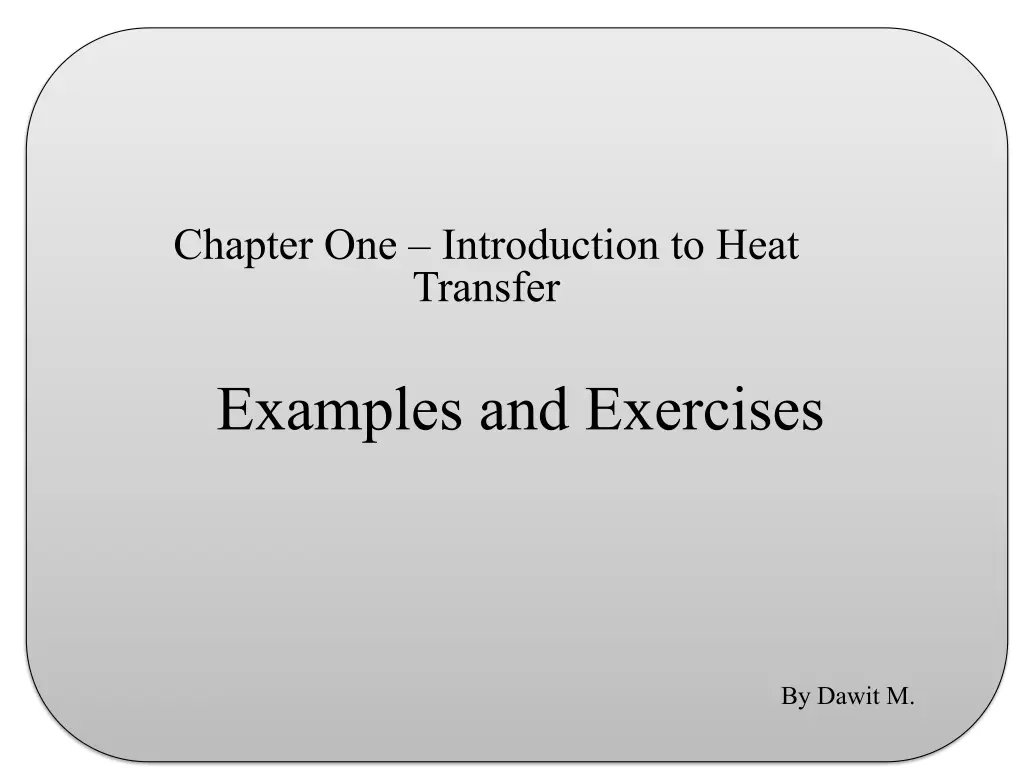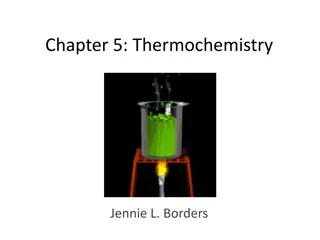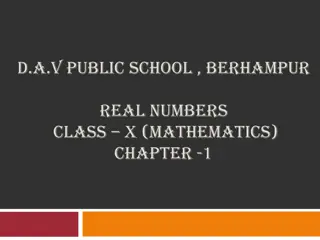
Heat Transfer Examples and Exercises with Dawit M.
Dive into examples of heat transfer problems with solutions and exercises in this comprehensive guide by Dawit M. Explore scenarios like conduction across a plane wall, convection heat dissipation from a transistor, surface-to-surface heat exchange, and closed system energy balance analysis.
Download Presentation

Please find below an Image/Link to download the presentation.
The content on the website is provided AS IS for your information and personal use only. It may not be sold, licensed, or shared on other websites without obtaining consent from the author. If you encounter any issues during the download, it is possible that the publisher has removed the file from their server.
You are allowed to download the files provided on this website for personal or commercial use, subject to the condition that they are used lawfully. All files are the property of their respective owners.
The content on the website is provided AS IS for your information and personal use only. It may not be sold, licensed, or shared on other websites without obtaining consent from the author.
E N D
Presentation Transcript
Chapter One Introduction to Heat Transfer Examples and Exercises By Dawit M.
Analysis of Heat Transfer - Methodology Known: After carefully reading the problem, state briefly and concisely what is known about the problem. Do not repeat the problem statement. Find: State briefly and concisely what must be found. Schematic: Draw a schematic of the physical system. If application of the conservation laws is anticipated, represent the required control volumes or surfaces by dashed lines on the schematic. Identify relevant heat transfer processes by appropriately labeled arrows on the schematic. Assumptions: List all pertinent simplifying assumptions. Properties: Compile property values needed for subsequent calculations and identify the source from which they are obtained. Analysis: Begin your analysis by applying appropriate conservation laws, and introduce rate equations as needed. Develop the analysis as completely as possible before substituting numerical values. Perform the calculations needed to obtain the desired results. Comments: Discuss your results. Such a discussion may include a summary of key conclusions, a critique of the original assumptions, and an inference of Analysis of Heat Transfer Problems: Methodology trends obtained by performing additional what-if and parameter sensitivity calculations.
Example 1: Conduction across a Plane Wall 1) The wall of a house, 7m wide and 6m high is made from 0.3m thick brick K = 0.6W/mK. The surface temperature on the inside of the wall is 160C and that on the outside is 60C. Find the heat flux through the wall and the total heat loss through it.
Example 2: Convection Heat Dissipation from Transistor 2) The case of a power transistor, which is of length L = 10 mm and diameter D = 12 mm, is cooled by an air stream of temperature T = 250C. Under conditions for which the air maintains an average convection coefficient of h = 100 W/m2 K on the surface of the case, what is the maximum allowable power dissipation if the surface temperature is not to exceed 850C?
Example 3: Surface to Surface Heat Exchange 3) An un-insulated steam pipe passes through a room in which the air and walls are at 25 C. The outside diameter of the pipe is 70 mm, and its surface temperature and emissivity are 200 C and 0.8, respectively. If the coefficient associated with free convection heat transfer from the surface to the air is 15 W/m2 K, what is the rate of heat loss from the surface per unit length of pipe? (Assume gray sruface, = )
Example 4: Closed System Energy Balance 4) A long conducting rod of diameter D and electrical resistance per unit length Re is initially in thermal equilibrium with the ambient air and its surroundings. This equilibrium is disturbed when an electrical current I is passed through the rod. Develop an equation that could be used to compute the variation of the rod temperature with time during the passage of the current.
Exercise 1) Consider steady heat transfer between two large parallel plates at constant temperatures of T1 = 300 K and T2 = 200 K that are L = 1 cm apart, as shown in Fig. below. Assuming the surfaces to be black (emissivity = 1), determine the rate of heat transfer between the plates per unit surface area assuming the gap between the plates is: (a) filled with atmospheric air, (a) evacuated, (b) filled with urethane insulation, and (c) filled with superinsulation that has an apparent thermal conductivity of 0.00002 W/m C.
Thank You Any Question?






















